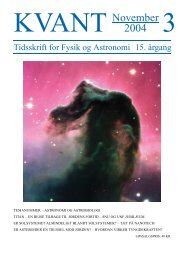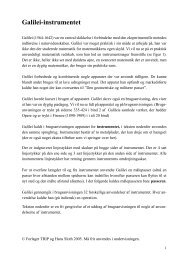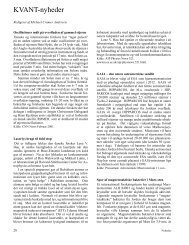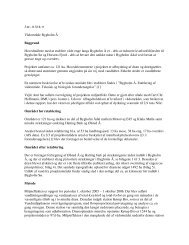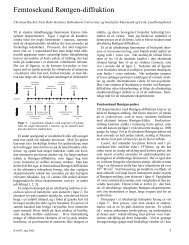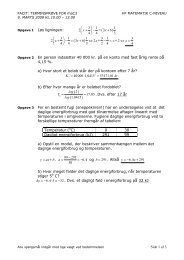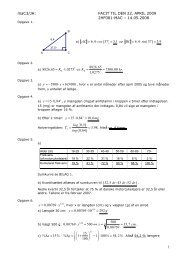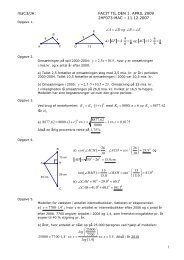Chapter 7 The Outer Planets
Chapter 7 The Outer Planets
Chapter 7 The Outer Planets
You also want an ePaper? Increase the reach of your titles
YUMPU automatically turns print PDFs into web optimized ePapers that Google loves.
214 <strong>Chapter</strong> 7 <strong>The</strong> <strong>Outer</strong> <strong>Planets</strong><br />
FIGURE 7-37 Neptune’s Rings Two main<br />
rings are easily seen in this view alongside overexposed<br />
edges of Neptune. Careful examination<br />
also reveals a faint inner ring. A fainter-still sheet of particles, whose<br />
outer edge is located between the two main rings, extends inward<br />
toward the planet. (NASA)<br />
WEB LINK 7.25<br />
VIDEO 7.11<br />
satellite and planet could form together but rotate in opposite<br />
directions. Indeed, only a few of the small outer satellites<br />
of Jupiter and Saturn have retrograde orbits, and these bodies<br />
are probably captured asteroids. Some scientists have<br />
therefore suggested that Triton may have been captured 3 or<br />
4 billion years ago by Neptune’s gravity.<br />
Upon being captured, Triton was most likely in a highly<br />
elliptical orbit. However, the tidal force the moon creates on<br />
Neptune’s liquid surface would have made Triton’s orbit<br />
more circular. Conversely, the tidal force created on Triton by<br />
Neptune due to the moon’s changing distance to Neptune<br />
would have caused the moon to stretch and flex, providing<br />
enough energy to melt much of the satellite’s interior and<br />
obliterate Triton’s original surface features, including craters.<br />
Triton’s south polar region is shown in Figure 7-38. Note<br />
that very few craters are visible. Calculations based on these<br />
observations indicate that Triton’s present surface is about<br />
100 million years old.<br />
Triton does exhibit some surface features seen on other<br />
icy worlds, such as long cracks resembling those on Europa<br />
and Ganymede. Other features unique to Triton are quite<br />
puzzling. For example, the top half of Figure 7-38 reveals a<br />
wrinkled terrain that resembles the skin of a cantaloupe.<br />
Triton also has a few frozen lakes like the one shown in<br />
Figure 7-39. Some scientists have speculated that these lakelike<br />
features are the calderas of extinct ice volcanoes. A mixture<br />
of methane, ammonia, and water, which can have a<br />
melting point far below that of pure water, could have<br />
formed a kind of cold lava on Triton.<br />
Voyager instruments measured a surface temperature of<br />
36 K (–395ºF), making Triton the coldest world that our<br />
probes have ever visited. Nevertheless, Voyager cameras did<br />
glimpse two towering plumes of gas extending up to 8 km<br />
above the satellite’s surface. <strong>The</strong>se are apparently plumes of<br />
nitrogen gas warmed by interior radioactive decay and<br />
escaping through vents or fissures.<br />
In the same way that our Moon raises tides on Earth,<br />
Triton raises tides on Neptune. Whereas the tides on Earth<br />
cause our Moon to spiral outward, the tides on Neptune<br />
cause Triton (in its retrograde orbit) to spiral inward. Within<br />
the next quarter of a billion years, Triton will reach the<br />
Roche limit, the distance at which a planet creates tides on its<br />
moon’s solid surface high enough to pull its moon apart.<br />
Pieces of Triton will then literally float into space until the<br />
entire moon is demolished! By destroying Triton, Neptune<br />
South polar region<br />
Canteloupe terrain<br />
Dark, wind-blown<br />
deposits<br />
FIGURE 7-38 Triton’s South Polar Cap<br />
Approximately a dozen high-resolution Voyager 2<br />
images were combined to produce this view of<br />
Triton’s southern hemisphere. <strong>The</strong> pinkish polar cap is probably made of<br />
nitrogen frost. A notable scarcity of craters suggests that Triton’s surface<br />
was either melted or flooded by icy lava after the era of bombardment<br />
that characterized the early history of the solar system. (NASA)<br />
7.13<br />
7.12<br />
VIDEO<br />
VIDEO




